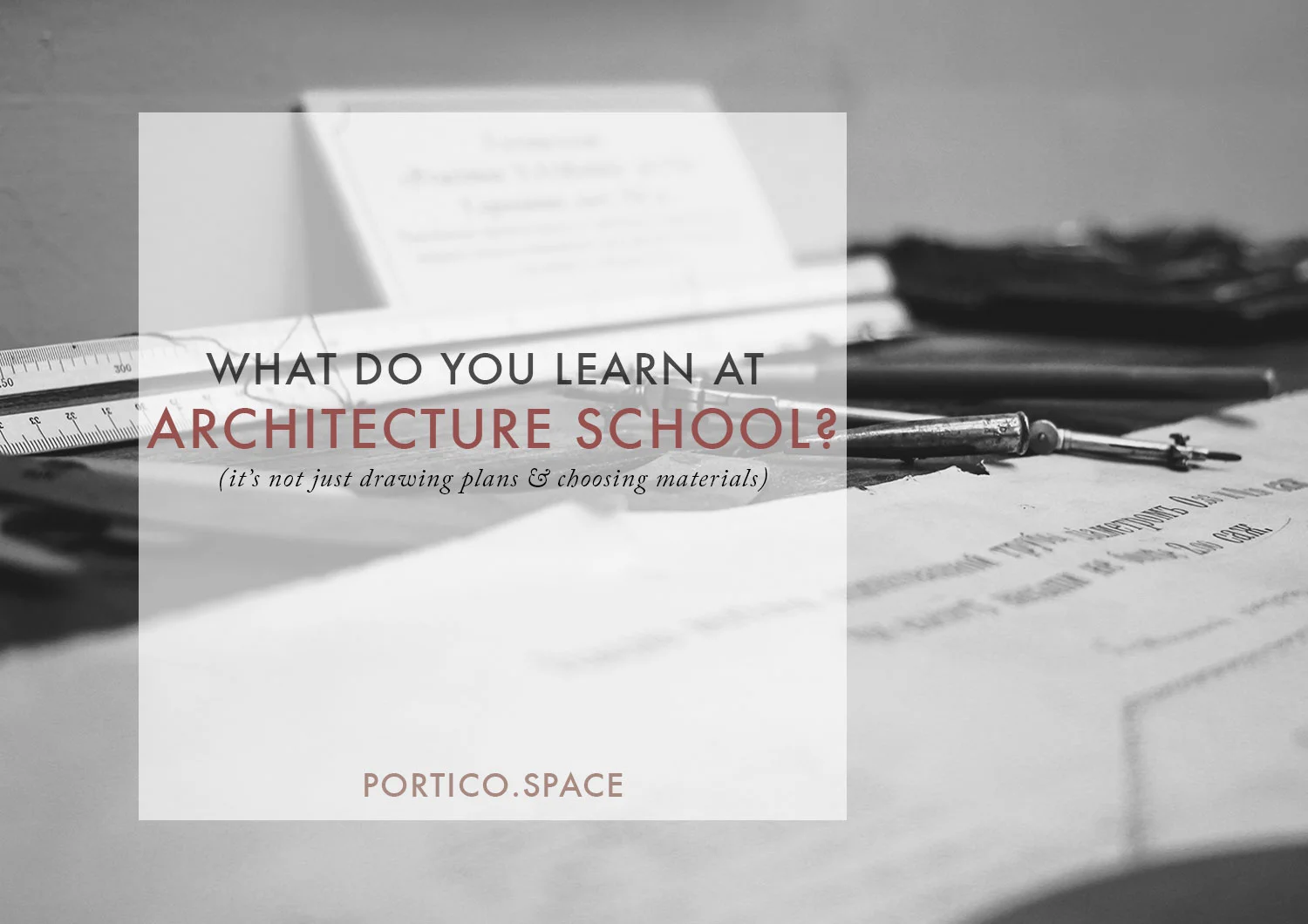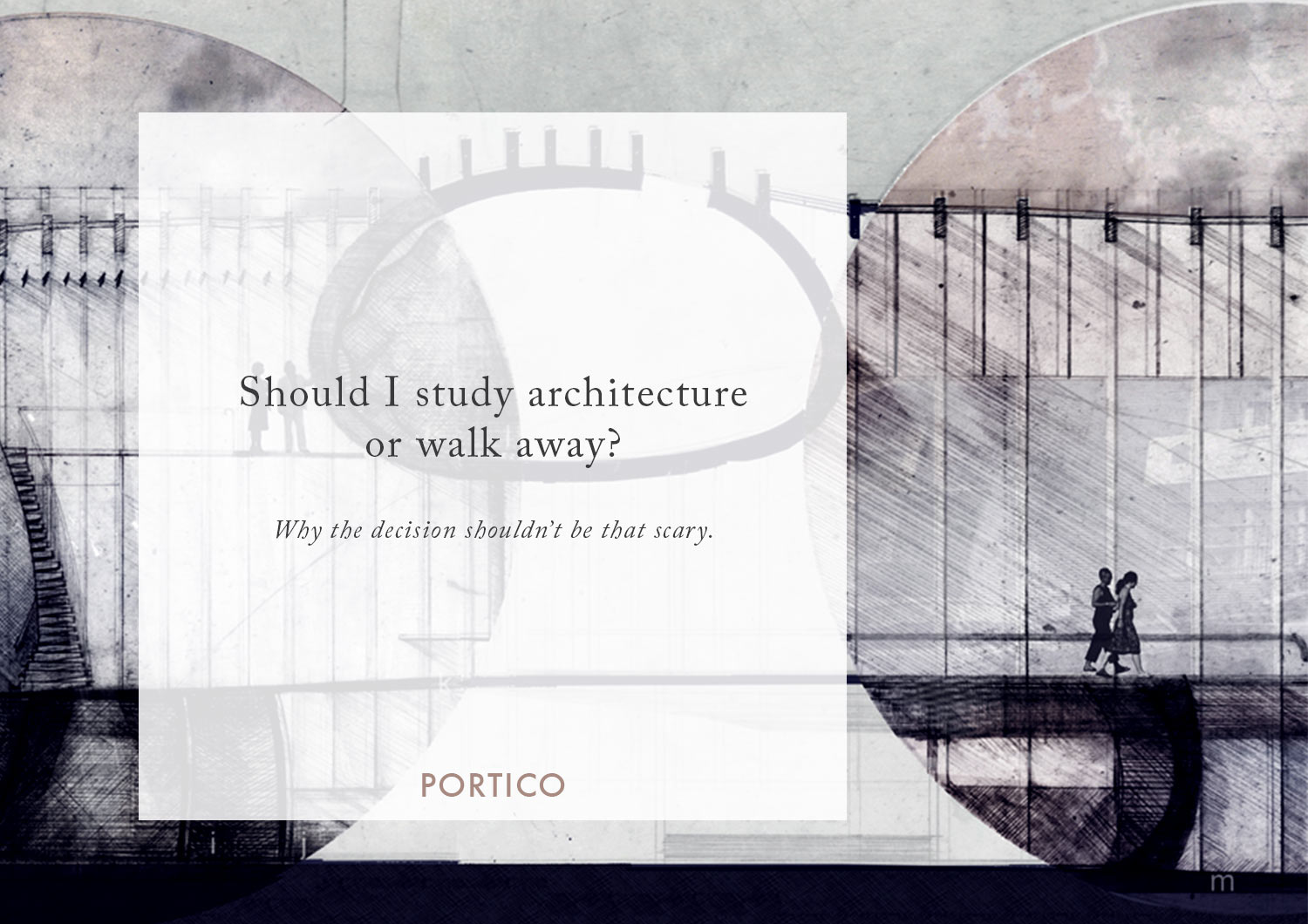WHAT DO YOU LEARN AT ARCHITECTURE SCHOOL?
"So, what do you learn at Architecture School, anyway?"
It's a simple question, but it's also the one I am asked most often, both by readers of Portico and by anyone who happens to know I studied architecture: friends in different fields, family members, and people I've just met. It sometimes seems like everyone is interested in architecture, but no one knows quite what it is or exactly how you go about doing it.
That's why it's a fairly understandable question, really. Most teenagers won't have met an architect, let alone understand what they do everyday, or what you might need to learn to become one.
Funnily enough though, my answer is never that in Architecture School "you learn to draw plans," or "you learn how to build houses." As Gary Stevens writes in The Favored Circle, it's not about learning to "do architecture."
But I also don't usually respond that "you learn to become an architect." Instead, my most-used line is:
At Architecture School you learn two things:
first, How to think architecturally; and then
how to apply your architectural thinking.
THINKING ARCHITECTURALLY
What does it mean to 'think architecturally'?
The work of architects is rich and varied, and requires a wide range technical, creative, practical and strategic thinking.
Thinking architecturally is really about how you identify problems, understand their components, and are able to re-conceptualise problems as opportunities. Even when faced with a very difficult situation, architects get excited about the possibilities of what a project could be, what they could make happen. It's design, but it's also broader than design.
Architectural thinking is about how you see the world, how you approach a project, and how you are able to synthesise these varied ideas into a rich outcome. Architectural thinking is different for everyone - because everyone brings a different response, ethical stance, or set of skills.
HOW DO YOU APPLY 'ARCHITECTURAL THINKING'?
At Architecture School, learning to apply architectural thinking happens through projects - across a range of courses - but often with emphasis on design projects, which seek to integrate varied thinking. Applying your thinking is about how you set up systems, carry out tasks and execute your goals.
In my mind, 'applying architectural thinking' is also one way of explaining all the things an architect does beyond design. Beyond that, it also suggests a wider range of practices and opportunities that can be uncovered through studying architecture - from other design careers, to academia, entrepreneurship and beyond.
How you apply architectural thinking encompasses the things you need to do in preparation or in the background. These are the systems and tasks that free up space for you, allowing you to think architecturally. This includes understanding the business side of architecture, developing your marketing and communication skills, having a good understanding of structural systems, and being able to manage building compliance methods and processes. Being able to do all these things - either individually or as part of a wider team - is fundamental to allow you to think architecturally.
AN ARCHITECTURAL EDUCATION
Like the practice of architectural thinking, architectural education is rich and varied. At Architecture School, you don't just take one 'architecture' course - you'll take a range of courses.
In the beginning, each of the strands of study might seem quite separate - some will be scientific, some historic, and some more creative. But, as you progress through your study, the areas of learning will come to overlap more and more. Your final 'thesis' project will typically be your chance to integrate all this learning into one highly-considered (and usually super exciting) project.
COURSES AT ARCHITECTURE SCHOOL
typically, each year you will focus on developing skills in these AREAS:
architectural design
Completing design projects, either on your own or in a group;
working in a dedicated studio space;
focusing on applying your skills to a project - a problem;
learning and testing design methods;
use analogue (hand) and digital drawing & modelling techniques;
honing skills of presentation and communication.
Construction
Understanding materials & their properties;
Learning about construction processes & methods,
Understanding how to develop detailing;
Learning principles of durability & weather-tightness and what affects these;
Learning about finishes - how to achieve them and the pros/cons of different applications.
theory
understanding the thinking behind design;
locating current practice against different theories;
thinking about design as a form of research;
developing a personal ethos and identifying aligned thinkers;
understanding the relationship between architecture and other practices.
Professional Practice
studying different types of architecture practice;
understanding the phases & stages of practice;
considering the key elements of management;
overview of the financial aspects of projects & architectural business;
understanding the legal and ethical obligations of architects;
developing knowledge of construction contracts & how they are administered.
Architectural Communication
sketching, drawing & modelling
graphic design, layout & presentation;
computer design methods;
written communication;
oral communication & giving a presentation.
Structures
fundamentally, the study of structures is about how buildings stay up!
knowing the structural components of buildings;
understanding the forces on a building, and how we design to manage these
structural calculations;
understanding the structural capacity of different materials and construction methods;
understanding how structural thinking can enhance architectural design.
history
understanding different styles, movements, and timeframes;
linking technological changes to changes in architectural design;
thinking about how different cultures have historically responded to their cultural, geographical and climatic needs;
how architecture is shaped by broader social, economic, and climatic change.
There are many overlaps between these areas, but this outline gives you a general idea.
Following this basic framework, the complexity will increase with each year level, as will the overlap. By the time you leave, you will be expected to be thinking about the history and theory behind a project, while designing it so that it is structurally sound, having an idea of how it will be constructed, and being able to communicate it in the best way possible.
YOU'LL LEARN DIFFERENT THINGS
AT DIFFERENT ARCHITECTURE SCHOOLS
The is also diversity between schools, with different universities choosing to privilege or excel in certain areas of study. Some universities are know for having a more technical approach, others are more theoretical and conceptual, while others might have a focus on sustainability or computer-design processes.
For example, most Polytechnic Institutions (Polytechs) place greater emphasis on the technical elements - the 'how-to' answers. This usually includes training in current professional practice standards and methods. However, they might place less emphasis on the broader thinking areas, such as history or theory, and on the creative design and communication practices.
This variety in architectural education mirrors the reality of the profession. The role of an architect encompasses a vast range of skills and ways of thinking. Architects are often generalists, but some specialise in particular areas: sustainability, conceptual work, project management.
FROM STUDENT TO ARCHITECT
THE SUBJECT & LEARNING MAP
You loosely map these areas of architectural education against your school subjects, drawing links from where you are now, to where you will be in the future - right through to what you will be doing in practice as an architect.
Thinking about it this way can help you to understand why you might select certain subjects over others at high school, or where you need to put some extra energy in. It's also pretty interesting as a current architecture student to think about which areas of architectural practice you might end up specialising in.
I've put together a diagrammatic map of these relationships, which you can use to trace your own options out. Click the button below to download your subject map!





